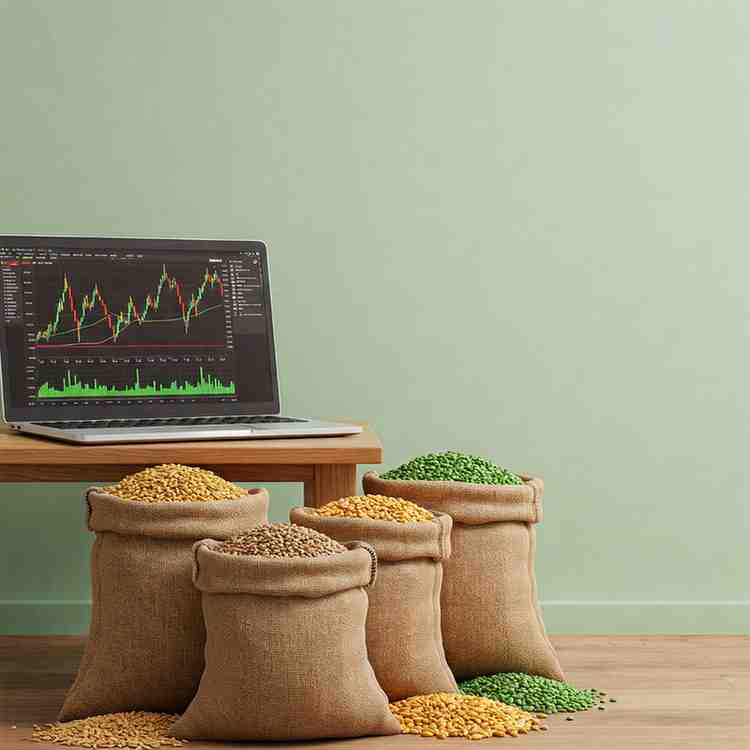
The Rising Appeal of Commodities for Indian Investors
The Rising Appeal of Commodities for Indian Investors
As astute observers of financial dynamics, you’ll note a discernible trend: an increasing cohort of investors is acknowledging the strategic imperative of incorporating commodities within their investment portfolios. In this epoch, characterized by the vicissitudes of economic cycles and the enduring specter of inflationary pressures, commodities present a salient pathway for augmenting portfolio value and a prospective bulwark against escalating price levels. Spanning the spectrum from precious metals, such as gold and silver, to fundamental resources like crude oil and agricultural yields, the realm of commodities unveils a panoply of compelling opportunities. Nevertheless, this dynamic market necessitates meticulous navigation and a robust comprehension of its inherent complexities. This introductory compendium endeavors to elucidate the principles governing the world of commodities, underscoring their potential merits and emphasizing the critical exigency for judicious and well-informed decision-making.
Thank you for reading this post, don't forget to subscribe!Why Consider Commodities? Unlocking Diversification and Inflation Protection
For too long, traditional investment strategies in India have heavily relied on equities and fixed-income instruments. While these asset classes form the bedrock of many portfolios, incorporating commodities can introduce valuable diversification and act as a crucial shield against inflationary pressures.
The Diversification Advantage: Breaking Free from Traditional Assets
One of the most compelling reasons to consider commodities is their low or even negative correlation with traditional assets like stocks and bonds. This means that when equity markets face a downturn, commodity prices might move independently or even in the opposite direction.
Imagine a scenario where the stock market is reeling from global economic uncertainty. Historically, during such periods, safe-haven assets like gold tend to see increased demand, potentially offsetting losses in the equity portion of your portfolio. This non-synchronous behavior acts as a vital cushion, reducing overall portfolio volatility and enhancing risk-adjusted returns. By diversifying beyond the conventional, investors can build more resilient portfolios capable of weathering different economic storms.
Commodities as an Inflation Shield for Indian Portfolios
Inflation, the erosion of purchasing power, is a significant concern for investors in India. Commodities, particularly raw materials and energy, often form the base of many goods and services. As demand increases or supply chain disruptions occur, the prices of these essential commodities tend to rise, directly contributing to inflationary pressures.
Conversely, this inherent link makes commodities a potential hedge against inflation. When the cost of living increases due to rising commodity prices, investments in these same commodities can appreciate in value, thus helping to preserve your portfolio’s purchasing power. Including commodities in your asset allocation can act as a strategic defense against the eroding effects of inflation on your overall wealth.
First Steps and Common Stumbles: Avoiding Early Mistakes in Commodity Trading
Embarking on the commodity investment journey requires careful consideration and a commitment to learning. Jumping in without adequate preparation can lead to costly mistakes.
Knowledge is Power: The Peril of Trading Without Understanding
The world of commodities is diverse, with each commodity possessing its own unique set of fundamental drivers. Trading gold is vastly different from trading crude oil or agricultural products. Gold, often seen as a safe-haven asset, is influenced by factors like geopolitical stability, interest rates, and investor sentiment. On the other hand, crude oil prices are sensitive to global supply and demand dynamics, geopolitical events in oil-producing regions, and technological advancements. Agricultural commodities like wheat or soybeans are heavily influenced by weather patterns, planting cycles, and global food demand.
Therefore, it is paramount to thoroughly understand the specific commodities you intend to trade. Research their historical price movements, the key factors that influence their supply and demand, and the intricacies of their respective markets. Trading without this foundational knowledge is akin to navigating uncharted waters without a compass.
The Supply-Demand Equation: A Fundamental Insight for Price Prediction
At the heart of commodity price movements lies the fundamental interplay of supply and demand. Understanding this equation is crucial for making informed trading decisions.
Factors affecting supply can range from natural events like adverse weather conditions impacting agricultural yields or geopolitical instability disrupting oil production to technological advancements that might increase the extraction or production of a particular commodity. On the demand side, economic growth typically fuels higher demand for industrial metals and energy, while changing consumer preferences or population growth can impact the demand for agricultural products. By closely monitoring these supply and demand dynamics and anticipating potential shifts, investors can gain valuable insights into future price trends.
Navigating the Instruments: Spot, Futures, and Derivatives in the Indian Context
In India, investors can participate in the commodity markets through various instruments, each with its own characteristics, risks, and rewards.
- Spot Prices: This refers to the current market price at which a commodity is traded for immediate delivery. While direct spot trading of physical commodities might be impractical for most individual investors, understanding spot prices is essential as they form the basis for other derivative instruments.
- Futures Contracts: These are standardized contracts obligating the buyer to purchase or the seller to deliver a specific quantity of a commodity at a predetermined price on a future date. Futures contracts offer leverage, allowing investors to control a larger quantity of the underlying commodity with a smaller initial margin. However, this leverage also amplifies potential losses.
- Derivatives: Beyond futures, other derivative instruments like options contracts provide the right, but not the obligation, to buy or sell a commodity at a specific price within a certain timeframe. Understanding the mechanics and risks associated with each of these instruments is crucial before engaging in commodity trading.
- It is vital for beginners to carefully consider their risk tolerance and investment objectives before choosing the appropriate instruments for their commodity exposure.
Conclusion: Laying a Solid Foundation for Commodity Investing
Integrating commodities into an investment portfolio can offer significant benefits in terms of diversification and inflation hedging for Indian investors. However, success in this market hinges on a strong foundation of knowledge and a cautious approach. Understanding the unique drivers of different commodities, appreciating the fundamental role of supply and demand, and navigating the various trading instruments with awareness are the crucial first steps.
This guide serves as an initial roadmap. In the journey ahead, further exploration of risk management techniques, in-depth market analysis, and staying abreast of global economic and geopolitical developments will be essential for building a robust and rewarding commodity investment strategy.
Related Blogs:
What is Commodity Trading?
Why Energy Commodities Deserve a Spot in Your Indian Investments
How to Diversify Your Portfolio with Commodities: A Strategic Approach
Top Strategies and Tips for Maximizing Profits in Commodity Trading
Different Types of Commodities and Their Trading Characteristics
Beyond Stocks: Exploring the World of Commodities
Diversification Strategies: Combining Commodities and Equities
Commodity vs Equity Market: A Beginner’s Guide to Understanding the Differences
What are Commodities? Understanding the Basics
Value Investing as a Stock Market Investing Strategy in 2025
Disclaimer: This blog post is intended for informational purposes only and should not be considered financial advice. The financial data presented is subject to change over time, and the securities mentioned are examples only and do not constitute investment recommendations. Always conduct thorough research and consult with a qualified financial advisor before making any investment decisions.

